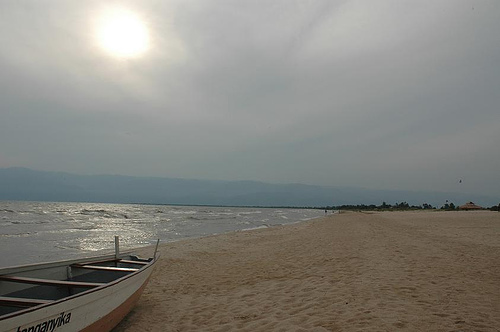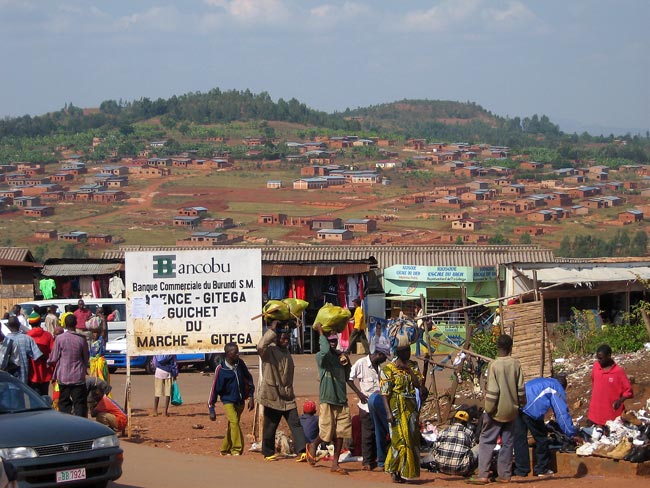PeopleBurundi has a population of 8,691,005 of which only 6% is urban. The people are 85% Hutu and 10% Tutsi, while less than 1% are of the Twa tribe. The two official languages are French and Kirundi, but Swahili is also widely spoken. The people are predominantly Christian, about 70% of the population, and of that, most are Roman Catholic. 23% of the people still practice animism. Like other places in Africa, the AIDS epidemic has taken its toll with an estimated 500,000 people displaced due to the epidemic.
|
Located in the Great Lakes region of Eastern Africa, the Republic of Burundi is an often-missed destination. But with such amazing scenery from mountains to forests, it is a beautiful country you won't want to miss. You can travel to the Chutes, the legendary source of the Nile River that so long eluded intrepid adventurers. The falling waters of the Kaguna Falls will awe you. Perhaps you would like to take a safari to see the diverse wildlife including, lions, monkeys, and antelope, or you can track mountain gorillas like Diane Fossey. For a more cosmopolitan experience, visit the capital city of Bujumbura with modern hotels and shopping. You can relax on the beaches around Lake Tanganyika or enjoy water sports, as you ski past onlookers eating at the beachside cafes. Burundi is a hidden gem of a country that actually has much to offer the traveler. Whether you want to experience the natural wonders or the nightlife, Burundi has something for almost everyone. |
Geography
Burundi is a landlocked nation on the Albertino Rift section of the Great Rift Valley. Right in the center of Africa, it is a land of rolling plateaus and a tropical highland climate. Lake Victoria and Lake Tanganyika are the two main water sources for the Burundians. Temperatures range widely from 68 degrees Fahrenheit in the central plains to much higher temperatures in the lower elevations.
There are four distinct seasons in Burundi: The long dry season runs from June to August; the short wet season is September to November; the short dry season is December to June; and the long wet season is February to May. Rainfall is irregular and the country frequently suffers from drought.
There are four distinct seasons in Burundi: The long dry season runs from June to August; the short wet season is September to November; the short dry season is December to June; and the long wet season is February to May. Rainfall is irregular and the country frequently suffers from drought.
Famous AttractionWhile there are many lovely places in Burundi to visit, Lake Tanganyika stands out, specifically Saga Beach. Just five kilometers from the capital, it is named after the fabulous Saga resort. Whether you prefer to lounge on the beach, participate in water sports, or dine in the cafes, Saga Beach is the top vacation spot in Burundi.
Saga Beach isn't the only spot on Lake Tanganyika. It is the longest lake in the world and the second deepest and second largest in Africa. The lake is home to 214 species and surrounded by mountain vistas on one side and coastal plains on the other. Perhaps you want to see the natural wonders of Burundi. Try Ruvubu National Park that straddles the Ruvubu River. Established in 1980, the park is home to hippopotamus, buffalo, crocodiles, leopards, lions, monkeys, antelopes, and over 425 species of bird. To benefit the wildlife, human residents were excluded from the area, but there are campgrounds if you want to experience the park both night and day. |
HistoryThe Tutsi ruled Burundi for two hundred years but by the late nineteenth century they lost control to Germany and Belgium, when the colony was known as Rwanda-Urundi. After their defeat in World War I, Germany ceded control to Belgium, which allowed the continuation of the kingship dynasty. By World War II, the country was a United Nations Trust Territory under Belgian administration. However, the 1940's were a time of political unrest and division, often as a result of the policies of the Belgian administration.
In 1948 Belgium allowed the formation of political parties, and in January of 1959 Mwami Mwambutsa IV requested the separation of Burundi and Rwanda. Six months later political parties formed to bring attention to Burundi's desire for independence and separation from Rwanda. Throughout the independence process, tensions grew between the Hutus and the Tutsis. From 1959 through 1962, Hutu refugees fled to Rwanda to escape Tutsi persecution, and Tutsis fled to Burundi to escape the Hutus. On July 1, 1962, independence was granted to Burundi and Mwami Mwambutsa IV was named king. Two months later, on September 18, 1962, Burundi joined the United Nations. The country was set up as a constitutional monarchy with power evenly held by Hutu and Tutsi in parliament. Then Hutu forces took control of the country and forced the Tutsi out. In 1965, King Mwambutsa refused to appoint a Hutu prime minister. A coup was attempted but defeated. In 1966 Prince Ntare deposed his father. He was promptly deposed by the Tutsi Prime Minister Captain Michel Micombero who abolished the monarchy altogether. Infighting between Hutu and Tutsi continued to the point that the United Nations became involved and the country was patrolled by U.N. Peacekeeping forces until 2006 when reconstruction began. Peace talks continue. |
NightlifeIf it's nightlife you want, Bujumbura, the capital city, is your best bet, with bars, discos, cafes, and cinemas. Also, to satisfy the needs of foreign diplomats, there are international grade hotels that also offer entertainment. Lake Tanganyika also has cafes and nighttime entertainment. You can go almost anywhere and hear the "Burundi Beat" and dance the night away.
|
Culture
Burundi is a mostly rural country made up Hutu and Tutsi people. Small clans live as extended families in compounds call rujos. The majority is Christian but there are some small pockets of Islam and animism. Burundi has a strong oral tradition and there is a tradition of improvisational poetry contests, called kivivuga amazina, practiced by cattle herders. Football is a popular sport.
CuisineThe cuisine of Burundi is varied, and maize, cassava, plantains, corn, sweet potatoes, sorghum, beans, and cabbages are all part of the daily fare. Fish is also consumed when available. Burundi is known for bananas and beans, a dish made from red kidney beans and plantains, seasoned with salt and pepper. Boko Boko Harees is a paste made from chicken, wheat, onions, and turmeric. Try all these dishes to get the real taste of Burundi.
|
Qunar







